2025 April Fiber Picks
Carolina Jiménez
All That We Carry
at Hesse Flatow, 77 Franklin Street, NYNY 10013
On view: through April 26, 2025
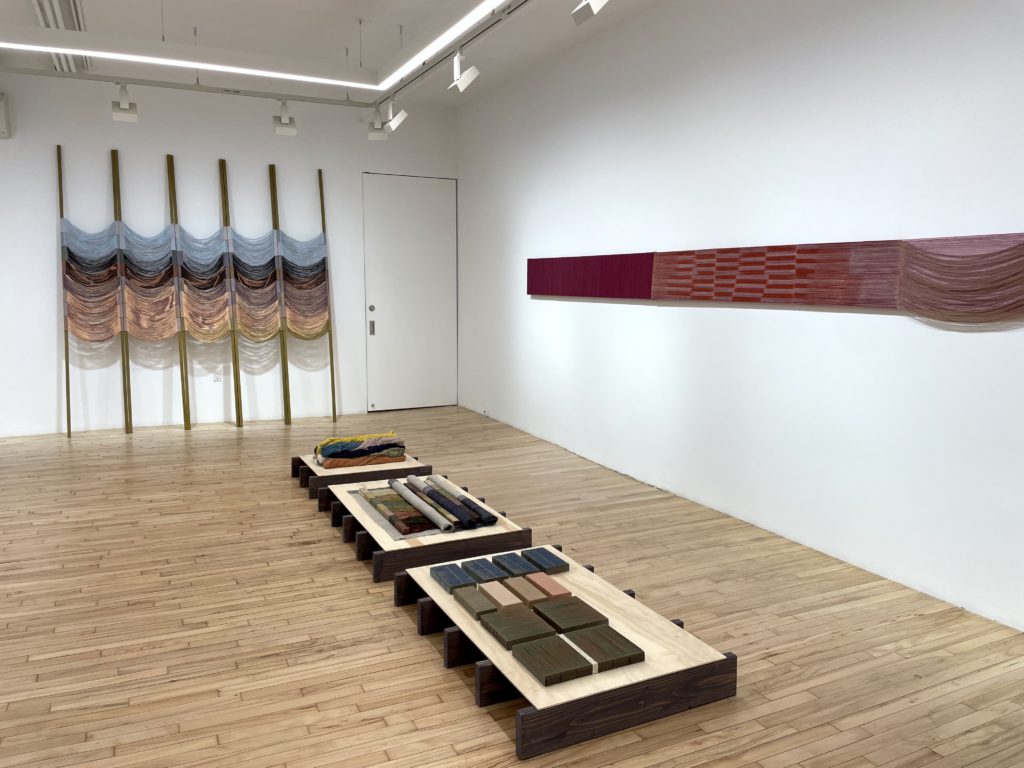

Masterfully merging fiber and color, texture and flatness, movement and stillness, the artist Carolina Jiménez, who refers to her works as “woven paintings,” creates work that transcends. On display through April 26th at Hesse Flatow in NYC is All That We Carry, an exhibition by fiber artist Carolina Jiménez that takes on elements beyond textiles into painting, sculpture, and installation. In this show, the artist’s first solo exhibition, Jiménez examines traditional weaving techniques and clothing designs of her parents’ Mexican heritage to create “synthetic explorations of remembered scents and feelings, especially as they arise around the people of special importance to her.”
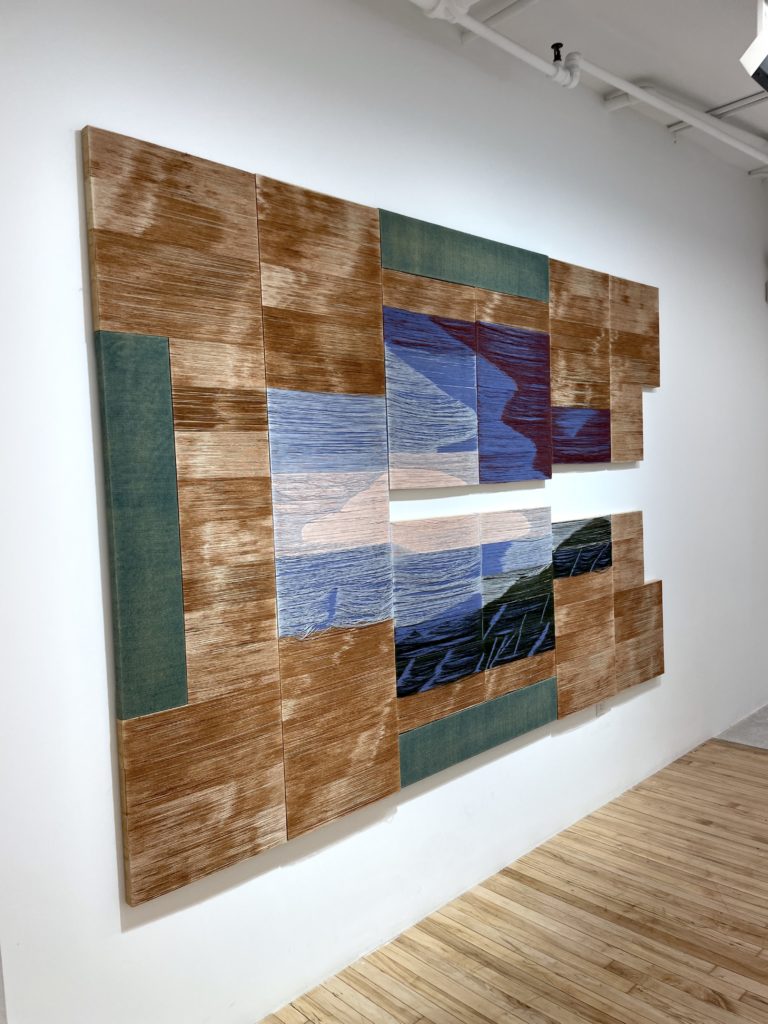
The exhibition space, located in the downstairs gallery, is quiet and intimate. As you turn the banister into the first room, the work titled Huipil, Me diste sopa de fideo, me diste el mundo (You gave me soup, you gave me the world, Huipil), (2024) greets you. This large piece—108x72 inches—is made up of more than a dozen panels, each with taut and draping linen and cotton weavings in desert hues of cutch, indigo, and fustic dyes, all puzzle-pieced together. It’s stunning and worth the show in itself. Viewing it, in your periphery, you can view the full second room—the entire exhibition—and an immediate takeaway is how each piece feels like a sister to each work—like a really good mixtape or concept album, all the twelve or so pieces in the show go together beautifully, creating an environment and certain calm.
Jiménez’s work in All That We Carry is organic yet geometric. In many of her woven paintings, here is a sense of geometry play and color exploration á la Josef Albers and the potent-yet-dulled color inherent in much dyework as well as the technical precision of Anne Albers—appropriate, as Jiménez just finished her residency at the Albers Foundation—yet her work is all her own. Geometry is complicated with gesture and the use of relief to create uncommon shapes, and precision is complicated by bulked fibers. Less of studies, these pieces feel whole and resolved.
Facing the door to the second room, standing alone at one wall at 96x85x14 inches, is the work Alone (with you) at the Pond, (2025). Almost like a deconstructed tapestry, the unwoven fibers in “jewel-toned hues”—blues into purples into pinks—cascade like waves between long wood panels. The panels themselves are structural, yet compositionally, they serve as the geometry that ties to the other works. Unlike most of the other works where the stretcher bars or frames for the woven paintings are covered by weavings or colored over, these wood beams remain raw and compositional. The beams also serve to secure the sculpture’s scalloping, unwoven weft, and, at the point where the beams and the fibers meet, the warp and weft become tight, intricate, and masterfully woven weavings stapled like a raw canvas. The work is stunning.
These descriptions hardly cover the range of works and processes Jiménez explores in this exhibition. In discussing this work, the idea of process came up often because there are layerings and weavings, wrapping and bundles, and combinations of those thoughtfully rendered. The different hats—the different processes—come to mind, but the creative, aesthetic, and conceptual decisions are paramount. The show’s curator, Kiko Aebi—also the Katz Curator at the Colby College Museum of Art in Maine—beautifully summerizes this in exhibition writeup: “Jiménez’s woven paintings operate as a taxonomy of material gestures: dyed, stretched, foled, rolled, bundled, unraveling, propped against or pinned to the wall, stacked, or crumpled in a heap. [...] Through their wrinkles and creases, frayed edges and processes of making and unmaking, [garments] are our second skins, correspondingly inscribed with indexical markers of our personal and cultural inheritances.”
Myrlande Constant
The Spiritual World of Haiti
at Fort Gansevoort, 5 Ninth Avenue, NYNY, 10014
On view: through April 26, 2025
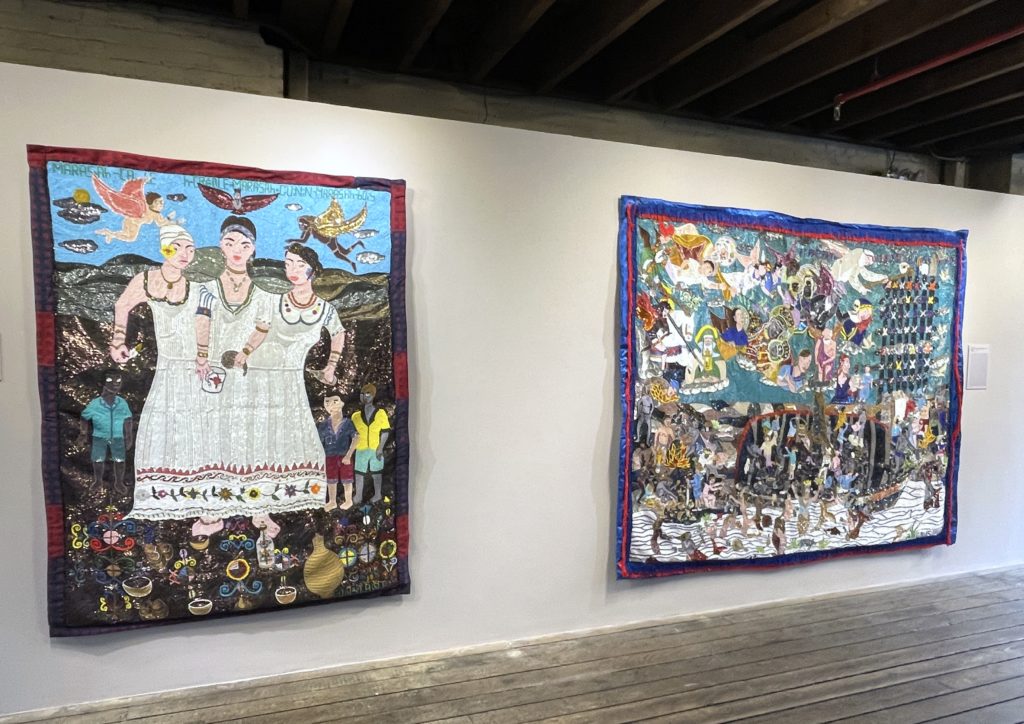
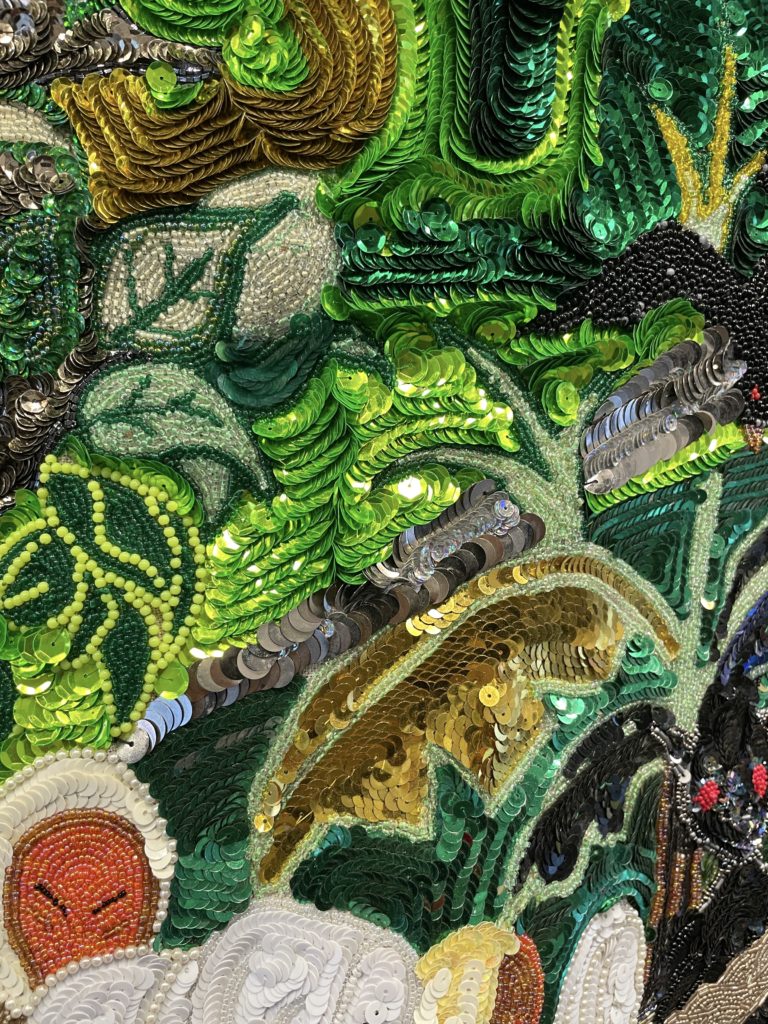
Although the Meatpacking District does have the Whitney Museum and the Highline, one might easily become overwhelmed, if not by the luxury and chain shops then by the sheer number of people. Art to the rescue! There is a respite, and that is the Fort Gansevoort gallery. And, if you go before April 26th, you will be doubly rewarded by the current exhibition, Myrlande Constant’s The Spirital World of Haiti.
This is Fort Gansevoort’s second solo exhibition by the internationally renowned Haitian artist. As a teenager in Port-au-Prince, she worked in a commercial wedding dress factory alongside her mother. There, she became a technical expert in tambour embroidery, in which sequence, beads, and embellishments are embroidered to fabric in a decorative style. In the 1990s, Constant applied this know-how to her art, creating intricate works of drapo Vodou—a term that encompasses multiple mediums of artworks that relate to Hatian Vodou spirituality, but here, and with Constant’s work specifically, in the form of beaded and sequenced tapestry-style flags.
These drapo Vodou flags are often traditionally created by men, and Constant’s female perspective is one of many values that makes her work different from traditional drapo. Other reasons include her use of “seed and bugle beads—a departure from traditional drapo use of sequins,” which lends to a painterly quality that is uniquely Constant’s own. In addition, her works include Vodou spirits, but also depict layered narratives about Haitian history and as well as outside stories. Constant’s works also are scaled larger than traditional drapo—in some instances, much larger; in others, much, much larger. (Some of her solid-beaded masterworks are over 12 feet large. They are awe-inspiring.)
Before I go further, let me say—and I might’ve said it before—that it is a pet peeve of mine when people ask textile artists about how long something took them to make. “I would run out of patience!” I’ve heard it a million times. This concept rarely comes up in other mediums—I can’t imagine someone asking a painter this, and I’ve always taken it as a slight when fiber arts conjure of the question of time well spent versus concept or aesthetics or provocation. I’m seeing things differently these days—seeing the commentary as a sign of appreciation as time well spent, possibly awe, and often a nostalgia for a relative or memory that is triggered by the medium. I believe this show has enabled me to get to that other side of this annoyance, seeing it as a connective question above anything. Tying this tangent in with Constant’s work—the intricacy of Constant’s works is undeniable, and the time-well-spent conversation is, too. These works are exceptional structures of detail and composition—one can get lost in the composition of the details themselves and not even see the many individual compositions and narratives that exist within each piece—not to mention the grand composition of the whole piece itself.
But Constant’s work is more than an aesthetic marvel; it is a dialogue between past and present, spirituality and materiality, tradition and innovation. Many, if not all, of the thirteen drapo Vodou on display in this 3-story exhibition depict lwa (Vodou spirits), sacred vèvè (ritual symbols), and historical narratives. In her hands, beads and sequins transcend mere decoration—the expansive, large compositions demonstrate her deep reverence for the traditions that inspire her. “These pieces are not just decorative objects but serve as powerful spiritual artifacts and expressions of resilience, faith, and identity within Haitian culture.”
Constant’s works are masterpieces. I urge you to go to Fort Gansevoort and marvel—be awed, be inspired, be moved by works of art that are technically humbling and artistically exceptional, compositionally layered, and that exude an uplifting, spiritual joyousness. My only advice is to not wait until the last day to see this show—you’ll want to return again and again. I’m going back tomorrow.
Special Mention—catch it while you can!
Daniela Gomez Paz
Walking through eyelets of fear, Aberturas al caminar
at Lyles & King, 19 Henry Street, NYNY 10002
On View: through April 5, 2025
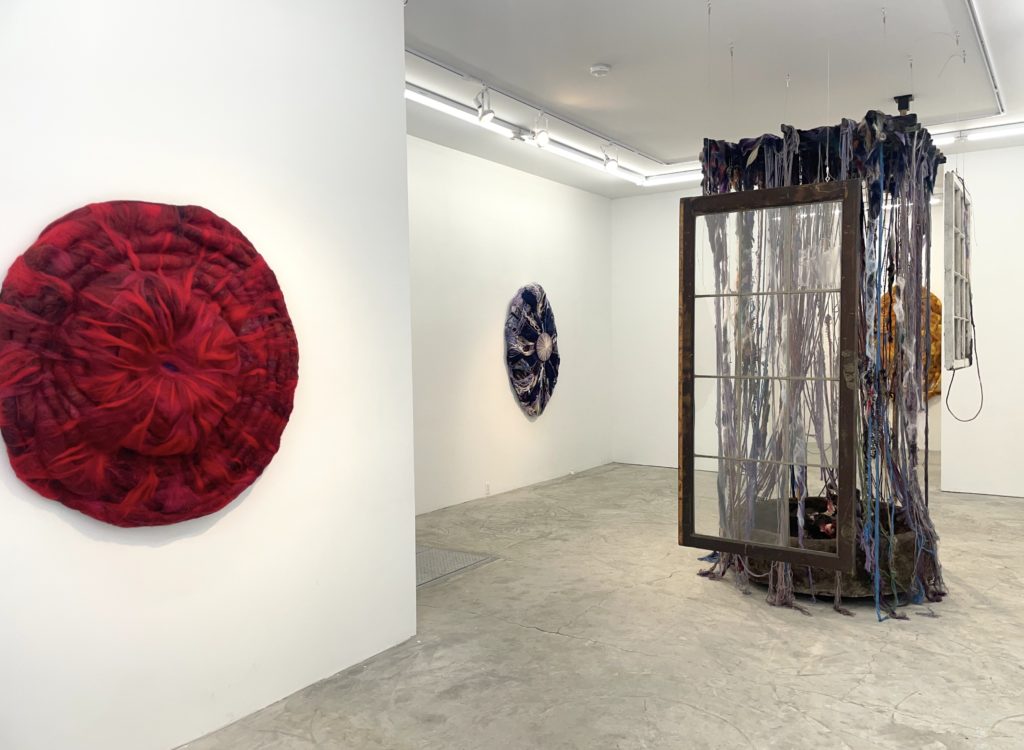
Daniela Gomez Paz’s exhibition, Walking through eyelets of fear, Aberturas al caminar, opened at Lyles & King gallery on February 28th and runs through April 5th. In this exhibition, the materiality of fiber is on full display in that Gomez Paz purposely worked the threads, whose intended materiality, they write, is to be woven together to create something “thin, malleable, and fluid” into something “dense and impenetrable.” With them, Gomez Paz investigates “fear as an abstract concept, manifesting itself into things like loss, uncertainty, grief, and a lack of clarity.” These sculptures feel extraterrestrial and portal-like, and if you find yourself in Chinatown before April 5th, do yourself a favor and pay them a hello.